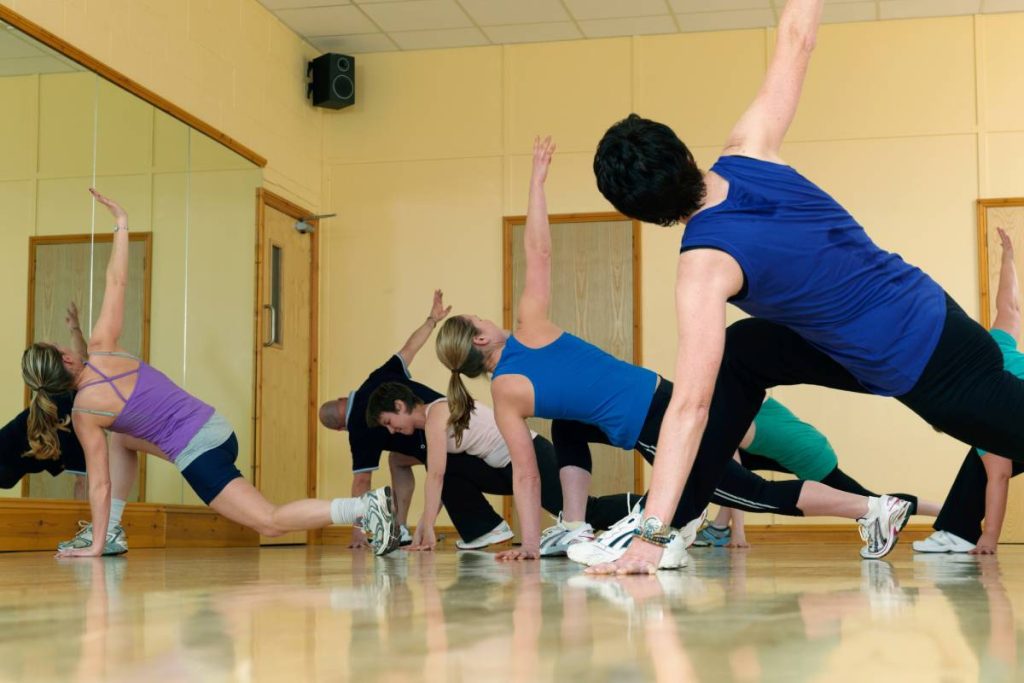Aerobic exercise, also called cardiovascular activity, gets your blood flowing and involves using large muscle groups. Examples include brisk walking, swimming, heavy cleaning, running, cycling, and playing soccer.
Health experts suggest aiming for at least 150 minutes of moderate aerobic exercise or 75 minutes of vigorous activity each week. Moderate activities like brisk walking or swimming are beneficial, while vigorous activities like running or cycling also offer advantages. Discover the reasons why aerobic exercise is recommended and get tips on how to include it in your routine.
We all know that aerobic exercise is good for our health, but how good it is exactly? Let’s find out.
Benefits of Aerobic Exercise
Enhances Heart Health
The American Heart Association and many doctors suggest aerobic exercise for individuals with, or at risk of, heart disease. This type of exercise strengthens the heart, making it more efficient at pumping blood throughout the body. It can also contribute to lowering blood pressure and keeping arteries clear by increasing “good” HDL cholesterol and decreasing “bad” LDL cholesterol levels. For those targeting blood pressure and cholesterol reduction, aim for 40 minutes of moderate to vigorous aerobic exercise 3 to 4 times per week.
Manages Blood Pressure
Aerobic exercise can aid in managing high blood pressure symptoms by helping to lower blood pressure. There are additional methods to reduce blood pressure without medication.
Regulates Blood Sugar
Regular physical activity assists in regulating insulin levels and lowering blood sugar levels while also managing body weight. A study on individuals with type 2 diabetes indicated that both aerobic and anaerobic exercises may have these benefits.
Alleviates Asthma Symptoms
Aerobic exercise has been shown to decrease the frequency and severity of asthma attacks. However, individuals with asthma should consult their doctor before starting a new exercise regimen. They may offer specific activities or precautions to ensure safety during workouts.

Eases Chronic Pain
For those dealing with chronic back pain, engaging in cardiovascular exercise, especially low-impact activities like swimming or aqua aerobics, could be beneficial. These exercises can help restore muscle function and endurance. Additionally, exercise aids in weight loss, which can further alleviate chronic back pain.
Improves Sleep
Struggling with sleep? Incorporating cardiovascular exercise into your daily routine might help. A study focusing on individuals with persistent sleep problems discovered that a regular exercise regimen combined with education on sleep hygiene effectively treats insomnia. Participants who engaged in aerobic activities for 16 weeks reported better sleep quality and duration, along with enhancements in daytime alertness and energy. It’s essential to avoid exercising too close to bedtime, as it may interfere with sleep. Aim to finish your workout at least two hours before bedtime for optimal rest.
Manages Weight
You’ve probably heard that diet and exercise are key to losing weight. Aerobic exercise, however, might be particularly effective in shedding pounds and maintaining weight loss.
In a study, overweight participants were instructed to maintain their usual diets but engage in exercise sessions burning 400 to 600 calories, five times a week, for 10 months. The results were remarkable: both men and women experienced significant weight loss, ranging from 4.3 to 5.7 per cent of their initial weights. Most participants opted for treadmill walking or jogging. If a treadmill isn’t accessible, try fitting brisk walks or jogs into your daily routine, like during breaks or before dinner.
Depending on your weight and pace, covering up to 4 miles may be necessary to burn 400 to 600 calories. Combining calorie reduction with aerobic exercise can decrease the amount of exercise needed to achieve the same weight loss goals.
Boosts Immune Function
Researchers at Pennsylvania State University investigated the effects of exercise on the immune systems of active and sedentary women.
Three groups were examined:
- One group exercised on a treadmill for 30 minutes.
- Another group performed a brief burst of intense activity lasting 30 seconds.
- The last group did not exercise at all.
Blood samples were collected from all women before, after, and at various intervals following these exercise sessions.
The findings revealed that regular and moderate aerobic exercise led to an increase in specific antibodies in the blood known as immunoglobulins, thereby strengthening the immune system. In contrast, the sedentary group showed no enhancement in immune system function, and their cortisol levels were significantly higher than those in the active groups.
Enhances Cognitive Function
Did you realize that brain tissue begins to decline after you turn 30? Researchers have found that aerobic exercise might help slow down this decline and enhance cognitive abilities.
To explore this idea, 55 older adults underwent magnetic resonance imaging (MRI) scans for analysis. Their health, including aerobic fitness, was also assessed. Those who were the most physically fit exhibited fewer reductions in brain tissue in key areas like the frontal, parietal, and temporal regions, indicating greater brain resilience overall.
What’s the takeaway? Aerobic exercise not only benefits the body but also boosts brain health.

Suitable for Everyone, Including Children
Cardiovascular exercise is beneficial for most individuals, regardless of age or existing health conditions. It’s important to collaborate with your doctor to determine the most suitable and safe exercise regimen for your specific circumstances.
Children, too, should engage in regular aerobic exercise. In fact, the recommendations for kids are slightly more than those for adults. Encourage your child to be active for at least 60 minutes or more every day. While moderate activities are beneficial, it’s also essential for kids to engage in vigorous exercise on at least three days each week.
Enhances Mood
Getting active can lift your spirits. In a study involving individuals with depression, participants engaged in treadmill walking with intervals for 30 minutes per session. After just 10 days, they were asked to note any changes in their mood.
Remarkably, all participants experienced a notable decrease in their depression symptoms. These findings indicate that even brief exercise sessions can have a significant impact on mood.
You don’t have to wait for nearly two weeks to feel better. The study also showed that even a single exercise session can provide a mood boost.
Reduces Fall Risk
Every year, one in three individuals aged 65 and above experiences a fall, which can result in serious injuries like broken bones and potentially lifelong disabilities. However, exercise can play a vital role in reducing this risk, regardless of your age.
A study focusing on women aged 72 to 87 found that engaging in aerobic dance sessions, for instance, can enhance balance and agility, thereby lowering the risk of falling. These women participated in hour-long workout sessions three times a week over a 12-week period. The dance routines included various movements such as squats, leg balancing, and other fundamental motor tasks.
By the end of the study, participants in the control group demonstrated significant improvements in tasks like maintaining balance on one leg with closed eyes. They also exhibited enhanced grip strength and reach, crucial physical abilities that help prevent falls.
Before initiating any new exercise regimen, it’s important to consult with your doctor and start gradually. Group classes can offer a safe environment for exercise, as instructors can provide guidance on proper technique and offer modifications to reduce the risk of injury.
Accessible and Affordable
You don’t have to break the bank or invest in fancy equipment to stay active. Incorporating daily exercise into your routine can be as simple as taking a stroll in your neighbourhood or jogging along a nearby trail with a friend.
Here are some other cost-effective ways to get your aerobic workout:
- Explore local schools or community centres for pool access. Many offer free entry for residents or have affordable rates. Some centres even provide complimentary or low-cost fitness classes.
- Utilize online resources for free workout videos. Platforms like YouTube host a variety of channels offering workouts at no cost. Popular options include Fitness Blender, Yoga with Adriene, and Blogilates.
- Inquire with your employer about gym membership discounts or free access. If your workplace doesn’t provide such benefits, you might qualify for incentives through your health insurance provider.

Is Aerobic Exercise Safe?
Before embarking on a new exercise regimen, it’s crucial to consult with your doctor. While aerobic exercise is generally suitable for most individuals, certain situations may require medical supervision.
For instance:
- If you have diabetes, monitor your blood sugar levels before and after exercise. Consuming a healthy snack before starting can help prevent low blood sugar levels.
- If you experience muscle and joint pain, like with arthritis, dedicate additional time to warming up before engaging in activity. Consider taking a warm shower beforehand or wearing supportive shoes with adequate cushioning.
- For individuals with asthma, opt for exercises involving shorter bursts of activity, such as tennis or baseball, allowing for rest periods to ease the strain on the lungs. Ensure you use an inhaler as needed.
- If you’re new to exercise, gradually ease into it over several weeks, starting with short sessions every other day to prevent fatigue and muscle soreness.
Your doctor can provide tailored advice and recommendations based on your specific health condition and fitness level.
Key Points to Remember
For most individuals, aiming for approximately 30 minutes of moderate cardiovascular activity at least five days a week is recommended. This totals around 150 minutes or 2 1/2 hours per week. Feel free to vary the intensity and types of activities to keep things engaging.
If you’re just starting out, begin with shorter and slower sessions, gradually increasing intensity as your fitness improves. Remember: Any amount of movement is beneficial, regardless of its duration.
If you’re short on time, consider breaking up your exercise throughout the day into multiple 10-minute segments. Even brief bouts of aerobic exercise can yield positive results. And hey, if you need a snack break, you can enjoy a delicious grilled cheese sandwich afterwards. If not much, what’s a foul about that, right?😜🤤

